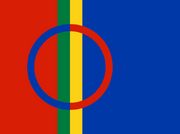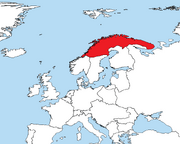Sapmi, officially known as the Sami Federation (Northern Sami Sámi Lhittováldi) is a country in northern Europe. It is a federal republic. Sapmi shares borders with Norway, Sweden, Finland and Russia.
Etymology:[]
Sápmi (and corresponding terms in other Sami languages) refers to both the Sami land and the Sami people. In fact, the word "Sámi" is only the accusative-genitive form of the noun "Sápmi"—making the nation's name (Sámi olbmot) simply mean "people of Sápmi." The source of the word is speculated to be related to the Baltic word *žēmē that simply means "land". The same word is speculated to be the origin of "Suomi", the Finnish name for Finland.
History:[]
Early History:[]
Since prehistoric times, the Sami people of Arctic Europe have lived and worked in an area that stretches over the regions now known as Norway, Sweden, Finland and the Russian Kola Peninsula. They have inhabited the northern arctic and sub-arctic regions of Fenno-Scandinavia and Russia for at least 5,000 years. The Sami are counted among the Arctic peoples and are members of circumpolar groups such as the [http:// Arctic Council Indigenous Peoples' Secretariat.]
Petroglyphs and archeological findings such as settlements dating from about 10,000 B.C. can be found in the traditional lands of the Sami. The now-obsolete term for the archaeological culture of these hunters and gatherers of the late Paleolithic and early Mesolithic is Komsa. A cultural continuity between these stone-age people and the Sami can be assumed due to evidence such as the similarities in the decoration patterns of archeological bone objects and Sami decoration patterns, and there is no archeological evidence of this population being replaced by another.
Recent archaeological discoveries in Finnish Lapland were originally seen as the continental version of the Komsa culture about the same age as the earliest finds on the coast of Norway. It is hypothesized that the Komsa followed receding glaciers inland from the Arctic coast at the end of the last ice age (between 11,000 and 8000 years B.C.) as new land opened up for settlement (e.g., modern Finnmark area in the northeast, to the coast of the Kola Peninsula). Since the Sami are the earliest ethnic group in the area, they are consequently considered an indigenous population of the area.
Independence and modern history:[]
The Sami people had by the 1600's been a part of the Scandinavian countries and Russia for hundreds of years, but after the successful russian invasion of northern Scandinavia, there was established an autonomous sami province in the region, and the sami was rallied against the scandinavian countries, which later paved the way to sami nationalism.
Due to political and ethnic instability in the Russian Empire, and the great war, large parts of Russia declared independence. Sapmi was declared as an independent socialist state in 1920. Sapmi and Finland was supposed to form a political union, but this plan ultimately failed due to large territorial disputes. Border skirmishes eventually lead to a war between Finland and Sapmi, where Sapmi lost a significant part of what is now modern day Finland. The socialist government was overthrown in 1985.


